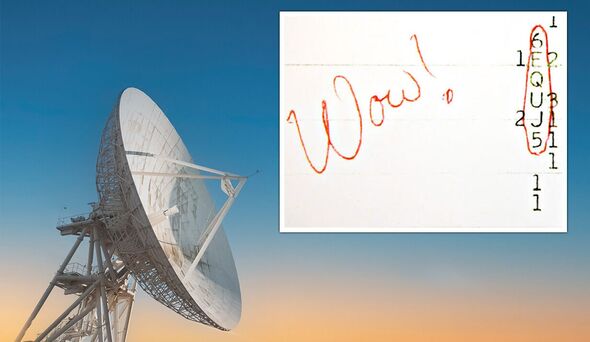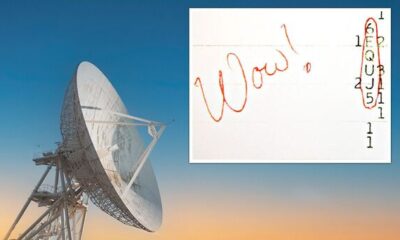Science
Scientists Unravel Cosmic Wow! Signal’s Natural Origin

A long-standing mystery surrounding a radio signal detected nearly five decades ago may have finally been solved. The so-called Wow! signal, first captured on August 15, 1977, by the Big Ear radio telescope at Ohio State University, has intrigued scientists and enthusiasts alike for years. Originally marked with a simple “Wow!” by astronomer Jerry Ehman, this unusual 72-second radio burst occurred at a frequency of 1420 MHz, which corresponds to hydrogen, the universe’s most abundant element.
In a recent study published on August 14, 2025, by the Arecibo Wow! Project, researchers have proposed a natural explanation for the enigmatic signal. The team, led by Professor Abel Mendez from the University of Puerto Rico, re-examined a vast archive of data, digitizing and refining approximately 75,000 pages of historical records. Their findings indicate that the Wow! signal was significantly stronger than previously believed, registering over 250 Janskys, and was more precisely localized within the constellation Sagittarius.
The researchers theorize that the signal resulted from a flare emitted by a magnetar, a type of highly magnetized neutron star, which interacted with a cold interstellar hydrogen cloud. This interaction could have led to a “maser flare,” a natural amplification of hydrogen emissions that resembles a cosmic laser. Their analysis suggests this explanation aptly accounts for the signal’s intensity, narrow bandwidth, and unique occurrence.
In their study, the team also ruled out various terrestrial interference sources, including satellites and television transmissions, as well as previous hypotheses linking the signal to comets or reflections from space debris. Observations from the Arecibo telescope prior to its collapse in 2020 had indicated weaker emissions from hydrogen clouds, aligning with the new theory.
Despite these findings, caution remains among some scientists. The 1420 MHz frequency is still regarded as a promising candidate for potential extraterrestrial communications. Past researchers, including John Kraus, director of the Big Ear, regarded the Wow! signal as “highly suggestive” of an intelligent origin. The possibility of alien involvement cannot be entirely dismissed, especially in light of the recent discovery of interstellar comet 3I/ATLAS (C/2025 N1), which is traversing the solar system from the same region of Sagittarius. While some researchers have speculated on a link between the comet and the Wow! signal, most astronomers argue that its observed characteristics are typical of comets.
The Wow! signal remains a significant candidate in the ongoing search for extraterrestrial intelligence (SETI). Other notable signals, such as the short-lived radio burst known as “SHGb02+14a” identified in 2003, and unexplained narrowband signals from Proxima Centauri investigated in 2020, were later attributed to natural or terrestrial origins. These examples highlight the challenges faced by scientists in distinguishing genuine alien transmissions from cosmic noise.
Professor Mendez stated that this new analysis does not close the investigation but rather “reopens it, with a much sharper map.” The team aims to complete the digitization of all Big Ear data by 2027, coinciding with the 50th anniversary of the Wow! signal’s initial detection. Future advancements, such as the Square Kilometre Array, are expected to enhance sensitivity and may ultimately clarify whether the Wow! signal was a rare natural phenomenon or potentially something more.
-

 Entertainment3 months ago
Entertainment3 months agoAnn Ming Reflects on ITV’s ‘I Fought the Law’ Drama
-

 Entertainment4 months ago
Entertainment4 months agoKate Garraway Sells £2 Million Home Amid Financial Struggles
-

 Health3 months ago
Health3 months agoKatie Price Faces New Health Concerns After Cancer Symptoms Resurface
-

 Entertainment3 months ago
Entertainment3 months agoCoronation Street’s Carl Webster Faces Trouble with New Affairs
-

 Entertainment3 months ago
Entertainment3 months agoWhere is Tinder Swindler Simon Leviev? Latest Updates Revealed
-

 Entertainment4 months ago
Entertainment4 months agoMarkiplier Addresses AI Controversy During Livestream Response
-

 Science1 month ago
Science1 month agoBrian Cox Addresses Claims of Alien Probe in 3I/ATLAS Discovery
-

 Entertainment4 months ago
Entertainment4 months agoKim Cattrall Posts Cryptic Message After HBO’s Sequel Cancellation
-

 Entertainment3 months ago
Entertainment3 months agoOlivia Attwood Opens Up About Fallout with Former Best Friend
-

 Entertainment6 days ago
Entertainment6 days agoCoronation Street Fans React as Todd Faces Heartbreaking Choice
-

 Entertainment3 months ago
Entertainment3 months agoMasterChef Faces Turmoil as Tom Kerridge Withdraws from Hosting Role
-

 Entertainment4 months ago
Entertainment4 months agoSpeculation Surrounds Home and Away as Cast Departures Mount











